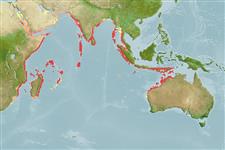>
Acanthuriformes (Surgeonfishes) >
Acanthuridae (Surgeonfishes, tangs, unicornfishes) > Acanthurinae
Etymology: Acanthurus: Greek, akantha = thorn + Greek, oura = tail (Ref. 45335).
More on author: Bennett.
Environment: milieu / climate zone / depth range / distribution range
Ökologie
seewasser riff-verbunden; tiefenbereich 0 - 25 m (Ref. 9710), usually 0 - 25 m (Ref. 27115). Tropical; 23°C - 28°C (Ref. 27115); 26°N - 30°S, 31°E - 129°E
Indian Ocean: eastern Africa to the Andaman Sea, southwest Indonesia and Christmas Island; with range extended to Bali, Indonesia in Western Pacific (Ref. 37792).
Length at first maturity / Size / Gewicht / Alter
Maturity: Lm 13.8 range ? - ? cm
Max length : 54.0 cm TL Männchen/unbestimmt; (Ref. 30573); common length : 19.0 cm TL Männchen/unbestimmt; (Ref. 30573)
Rückenflossenstacheln (insgesamt) : 9; Rückenflossenweichstrahlen (insgesamt) : 28 - 30; Afterflossenstacheln: 3; Afterflossenweichstrahlen: 23 - 26. Blue with a white chest (Ref. 3145). Head black with a broad white band from pectoral-fin base to throat. No distinct white spot or broad white band below eye. Dorsal fin yellow (except white margin and black submarginal line). Anal and pelvic fins white (Ref 9808).
Inhabits shallow, clear coastal and island coral reefs (Ref. 9710). Usually found on reef flats and along upper seaward slopes (Ref. 9710). May occur singly or in large feeding aggregations. Monogamous (Ref. 52884). Feeds on benthic algae; on small, sparsely scattered algae and small growths in crevices (Ref. 28026). Caught with nets (Ref. 30573). Marketed fresh.
Life cycle and mating behavior
Geschlechtsreife | Fortpflanzung | Ablaichen | Eier | Fecundity | Larven
Paired spawning (Ref. 240). Monogamous mating is observed as both obligate and social (Ref. 52884).
Randall, J.E., 1956. A revision of the surgeonfish genus Acanthurus. Pac. Sci. 10(2):159-235. (Ref. 1920)
IUCN Rote Liste Status (Ref. 130435: Version 2024-1)
Bedrohung für Menschen
Harmless
Nutzung durch Menschen
Fischereien: weniger kommerziell; Aquarium: Kommerziell
Tools
Zusatzinformationen
Download XML
Internet Quellen
Estimates based on models
Preferred temperature (Ref.
123201): 25.8 - 29, mean 27.5 °C (based on 354 cells).
Phylogenetic diversity index (Ref.
82804): PD
50 = 0.5000 [Uniqueness, from 0.5 = low to 2.0 = high].
Bayesian length-weight: a=0.02089 (0.01221 - 0.03575), b=2.93 (2.79 - 3.07), in cm total length, based on LWR estimates for this species & Genus-body shape (Ref.
93245).
Trophic level (Ref.
69278): 2.0 ±0.00 se; based on food items.
Widerstandsfähigkeit (Ref.
120179): mittel, Verdopplung der Population dauert 1,4 - 4,4 Jahre. (Preliminary K or Fecundity.).
Fishing Vulnerability (Ref.
59153): Moderate vulnerability (42 of 100).
Nutrients (Ref.
124155): Calcium = 43.2 [17.9, 124.2] mg/100g; Iron = 0.653 [0.249, 1.575] mg/100g; Protein = 18.3 [16.9, 19.5] %; Omega3 = 0.0883 [, ] g/100g; Selenium = 18.4 [6.3, 51.1] μg/100g; VitaminA = 33.7 [7.7, 135.1] μg/100g; Zinc = 2.52 [0.79, 4.63] mg/100g (wet weight);
